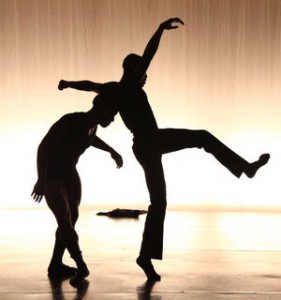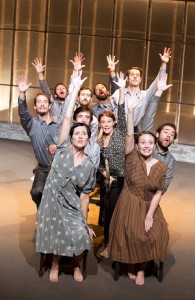Posted on Sun, Sep. 11, 2011
By Merilyn Jackson
Julie Diana in Slaughter on Tenth Avenue
‘I love dance as an art form,” says current Chicago mayor, former White House chief of staff, and onetime dance student Rahm Emanuel, a Chicago native who wants his city to be known for its moves. Like Philadelphia, it is a first-rate dance town, and, with Philadelphia, it is recognized by national dance media as one of the top five in the country. But it doesn’t eclipse Philadelphia.
Four well-established, critically acclaimed resident companies – the Pennsylvania Ballet, Philadanco, BalletX, and Koresh Dance Company – bring choreographic cachet to the Avenue of the Arts. This fall we’ll see another world-class season by Dance Celebration at Annenberg. And dozens of other small but robust companies will be presenting as part of a newly funded venue-rental program.
Our dance makers are artists, athletes, activists, healers, and teachers who may actually serve your diner breakfast the morning after you’ve seen them leap from the flies. With plucky start-ups bubbling like so many water-main breaks, you just can’t stem the tide of dancers here. Our own mayor would do well to tap them as role models for Philadelphia’s youth.
– Merilyn Jackson reviews dance for The Inquirer
Carbon Dance Theatre Carbon ironically calls its season-opening concert “Swan Songs.” World premieres by Kate Watson-Wallace, Matthew Neenan, and Carbon artistic director and retired Pennsylvania Ballet soloist Meredith Rainey are set to a range of final songs, from Schubert’s Schwanengesang to those of contemporary (if late) popular artists Amy Winehouse, Nick Drake, and Tupac Shakur. Oct. 28-30 at the Performance Garage (www.carbondancetheatre.com or www.ruddydance.org/garage/performances.).
Group Motion/Masaki Iwana As part of a long-established Japanese-American dance exchange, Group Motion presents a one-night-only chance to see Japan’s Butoh master, Iwana, in a solo dance, as well as the dance-theater artist Moeno Wakamatsu in Naked Water. Sept. 23 at the Community Education Center, 3500 Lancaster Ave. (215-387-19110
Subcircle Seed was conceived in New Zealand early this year and fleshed out in the Czech Republic over the summer as a duet for Niki Cousineau and Gin MacCallum, with choreographer Carol Brown directing and performance design by Jorge Cousineau. The multi-award-winning Cousineaus are founders of Subcircle, one of the city’s leading dance-theater companies. Nov. 2-5 at Christ Church Neighborhood House, 20 N. American St. (215-829-1449, [email protected]).
Philadanco It’s more than 40 years old, yet as young at heart as its founder, Joan Myers Brown. The company dances the Philadelphia premiere of Watching Go By, the Day by one of its former stars, Hope Boykin, on a bill with Gene Hill Sagan’s glamorous full ballet La Valse, Christopher Huggins’ all-male Blue, and Suite Otis by George Faison. Nov. 3-6 at the Perelman Theater (215-893-1999, www.kimmelcenter.org).
Headlong Dance Theater Desire, an original, full-length dance-theater piece directed by Swarthmore College’s K. Elizabeth Stevens, stars Headlong’s codirector/founders Amy Smith, David Brick, and Andrew Simonet. You’ve been waiting for this loopy trio to repossess your sensibilities with onions, hippos, and watermelons, haven’t you? Nov. 11-13 at Bookspace, 1113 Frankford Ave. (215-545-9195, www.headlong.org).
Lionel Popkin Here’s a not-to-be-missed chance to see former Philadelphian and Trisha Brown alum Popkin dancing in his quartet There is an Elephant in This Dance, joined by Carolyn Hall, Ishmael Houston-Jones, and a mystery guest, in the Philadelphia Dance Projects Presents 2011-2012 series, “Dance Up Close.” Gabrielle Revlock’s Share is also on the program. Nov. 18-19 at the Performance Garage (215-546-2552 or www.philadanceprojects.org.)
BalletX The often-puckish choreographer Matthew Neenan collaborates with composer Robert Maggio on a piece for the company’s dancers, with music scored for and performed live by Pennsylvania Ballet Orchestra cellists Jennie Lorenzo and Mark Ward. San Francisco-based choreographer Alex Ketley’s 2009 Silt repeats. Nov. 16-20 at the Wilma Theater (215-546-7824, www.wilmatheater.org).
Dance Celebration at Annenberg This stellar presenter has snared two of the world’s most brilliantly unorthodox choreographers in one season – Australia’s Gideon Obarzanek, founder of Chunky Move, and Montreal’s Marie Chouinard in her Compagnie Marie Chouinard.
Those who loved Obarzanek’s Mortal Engine at the Live Arts Festival two years ago – in which light displaces music as a driving force – will no doubt flock to see his new work with kinetic sculptor Reuben Margolin. In Connected (Nov. 17-19), the dancers construct Margolin’s sculpture in real time.
I cut my professional reviewing teeth on Marie Chouinard’s Rite of Spring shortly after it premiered in 1993. I’ve since seen at least seven other Rites by renowned choreographers, but none surpasses Chouinard’s for steamy atmosphere of a savage life cycle annually rising from the slime. No less turbulent will be her 24 Preludes by Chopin, also in its Philadelphia premiere. Dec. 8-10 at the Annenberg Center for the Performing Arts (215-898-3900, www.annenbergcenter.org).
Jack DeWitt, Steven Weisz and 7 others recommend this.
Read more: http://www.philly.com/philly/entertainment/20110911_A_wave_of_productions_will_show_why_Philadelphia_s_dance_scene_is_among_the_best_.html#ixzz1YifmbbiN
Watch sports videos you won’t find anywhere else


